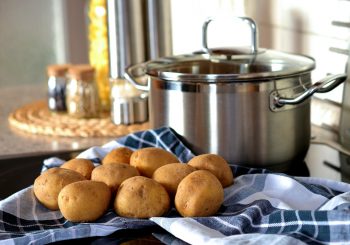Kitchen Fun Posted by Bjørn A. Bojesen on Sep 30, 2018 in Uncategorized
Kjøkkenet (the kitchen) is like the heart of a Norwegian home. When the clear autumn skies are turning dark – and the nearest restaurant feels a little bit too far away and pricey – it’s great for familie og venner (family and friends) to gather around spisebordet (the dining table).
Traditionally, matlaging (”making of food”, cooking) was done by the husmor (housewife, plural husmødre). Nowadays, of course, both men and women take turns preparing middagen (the dinner) – even if each hjem [yem] (home) is different.
Compared to the ones in other countries, Norwegian kitchens are quite romslig (roomy). 🙂 Although some people do have their dining table and stoler (chairs) somewhere else, it’s very common to eat one’s måltider (meals) in the kitchen…
A kitchen in Norway typically has a kjøleskap (fridge, literally ”cooling cupboard”) to conserve matvarer (foodstuffs), a fryser (freezer) to keep things like ice-cream from melting, skuffer og skap (drawers and cupboards) to store tools, a kjøkkenvask (kitchen basin) with spring (faucet/tap) to get vann (water), a kjøkkenbenk (work top/kitchen counter) to prepare food, and a komfyr [komFEER] (electric stove/cooker) to heat the food… And yes, Norwegians too get lazy and buy a mikrobølgeovn (micro wave oven)! 🙂
Let’s prepare some poteter (potatoes). You’ll need a potetskreller (potato peeler) to skrelle (peel) them and maybe a kniv (knife) and a skjærebrett (cutting board)… Del dem i to eller kutt dem i skiver eller firkanter. (Split them in two parts or cut them in slices or squares.) Put them in a gryte (pot) with kokende vann (boiling water), add salt and stir with a sleiv (ladle). (Remember to turn off kokeplaten, the hotplate, when they’re done!)
You can also steke (fry) them in fett (fat) on a stekepanne (frying pan), rive (shred) them on a råkostjern (shredder), bake (bake) them in ovnen (the oven) with the krydder (spice) of your choice, or mose (mash) them with an elektrisk visp (electric whisk) in a bolle (bowl).
When you’ve eaten, place the tallerken (dish), gaffel (fork), kniv, skje (spoon), glass (glass), mugge (mug), dørslag (sieve), grytelokk (saucepan lid) etc. in oppvaskmaskinen (the dishwasher). Finally, clean the duk (table cloth) with a fille (cloth)…
Of course, a lot of the fun in a kitchen comes from doing stuff sammen (together). Why not use your next kitchen session to practice your Norwegian?
Starting in October, this blog will appear only once a month. Stay tuned for new posts about Norwegian language and culture!

Build vocabulary, practice pronunciation, and more with Transparent Language Online. Available anytime, anywhere, on any device.




